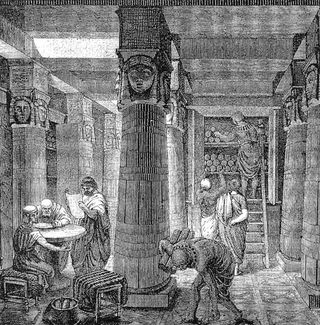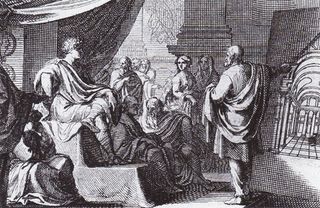10 ways the Romans still influence architecture
What have the Romans ever done for us? Their influence is all around, if you know where to look.

We modern designers reckon we've got the important stuff sorted. We're not as smart as we think though.
The Ancient Greeks had already mastered the most crucial aspects of art, design, philosophy and mathematics. Then, in about 48 BC, the great library at Alexandria catastrophically burned down, destroying the greatest repository of knowledge the world had known.
Win clients & work smarter with our FREE ebook: get it now!
It is fortunate, therefore, that Roman historian Vitruvius heroically documented his findings on design and construction. He wrote it up in his magisterial work, De Architectura – The Architect.
Armed with a Vitruvian manual, it's possible to see a 2000-year-old building project begin to look surprisingly modern. Here are 10 debts we owe the Romans...

01. The orders
Virtruvius produced his building bible, On Architecture, in the first century BC. In all there 10 books that deal with many aspects of building, the most famous being The Orders – rules about materials, methods of construction, and proportions.
The Orders can be best illustrated and understood by looking at a build's columns. The Greeks had three distinct families – Doric, Ionic and Corinthian. The Romans added two more: the Tuscan and Composite Orders.
Get the Creative Bloq Newsletter
Daily design news, reviews, how-tos and more, as picked by the editors.
Doric was said to represent the beauty of man; Ionic, the beauty of woman; and Ionic, the beauty of a maiden.
02. Design
Putting the needs of the occupants of the building first. Specifying safe and durable materials, fixtures and fittings. How the building fits into its surroundings and the creative effect that it has. There is much stimulating discussion on this point.
03. Think modules
A grid is the basis for a module which can be a measure of good proportion. A house plan based on say a 300mm module can lead to standardisation of products, ease of setting out and less waste. Greek houses were modular. Frank Lloyd Wright, the great American architect, designed many modular homes.
04. Sanitation
This is key to our existence today. For the Romans the problem of moving freshwater and the removal of waste were solved by simple gravity. This is still the easiest way to do it provided the gradients are right. Vitruvius recommended a gradient of 1: 4800 for aqueducts. So a fall of 10m equals a distance of 48 km or 29 miles! Drains today are commonly 1: 40.
05. Central heating
Under floor heating is much appreciated today. A system of ducts channelled heat under Roman floors which were topped by a screen and beautiful mosaics.
06. Cement - but not as we know it
Vitruvius reminds us that lime mortar is used to set bricks and lime with aggregate makes concrete. Not only that but concrete made with volcanic ash will set underwater. Traditional methods using lime are still common today perhaps because structures built in this way can absorb slight amounts of movement without cracking. Lime mortar would tick all the right ecological boxes today.
07. Plaster
Similar in Roman times as it is today, a mixture of lime and fine aggregates can be used both inside a building and outside. It has good adhesion, is breathable on natural backgrounds and will dry out without frost damage.
08. Decoration
A final limewash may do but decoration of Roman walls developed into an art form known as fresco painting. It is a highly skilled but quick method of applying pigments to wet plaster. Once the plaster sets the wall and painting are as one. There are many beautiful surviving frescoes. Is this practice worth resurrecting?
09. Getting about
Roman roads are famously durable and the principles are still followed today. Using course aggregates or Roman concrete on compacted earth, layers of smaller stones were added to fill voids left by the larger ones. Kerbs held the stone road surface in position while ditches and verges did the same job as they do today.
10. Sorting your site
The Romans weren't above getting their hands dirty and knew about working on difficult sites. They were proficient at dewatering so that foundations would not flood. They used technologies such as water lifting machines and pumps.
They were also adept at setting out the buildings, using a water level, plumbline and squares to ensure accuracy.
So, a building project with a 2000 year history itemised thanks mainly to the man who protected us from making avoidable mistakes – ‘Vitruvius the Great’.
Words: James Cooper
James Cooper is an architect, designer, art historian, and the UK's leading Grandfather.
Like this? Read this!
- The designer's guide to the Golden Ratio
- 6 tips for creating a spell-binding animation
- Leonardo da Vinci brought back to life with beautiful playing cards

Thank you for reading 5 articles this month* Join now for unlimited access
Enjoy your first month for just £1 / $1 / €1
*Read 5 free articles per month without a subscription

Join now for unlimited access
Try first month for just £1 / $1 / €1
The Creative Bloq team is made up of a group of design fans, and has changed and evolved since Creative Bloq began back in 2012. The current website team consists of eight full-time members of staff: Editor Georgia Coggan, Deputy Editor Rosie Hilder, Ecommerce Editor Beren Neale, Senior News Editor Daniel Piper, Editor, Digital Art and 3D Ian Dean, Tech Reviews Editor Erlingur Einarsson and Ecommerce Writer Beth Nicholls and Staff Writer Natalie Fear, as well as a roster of freelancers from around the world. The 3D World and ImagineFX magazine teams also pitch in, ensuring that content from 3D World and ImagineFX is represented on Creative Bloq.
